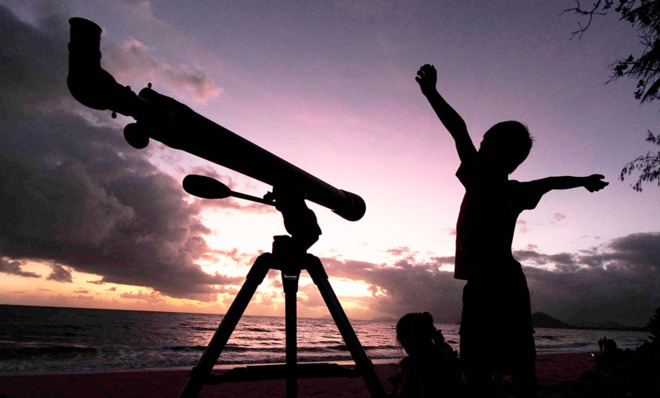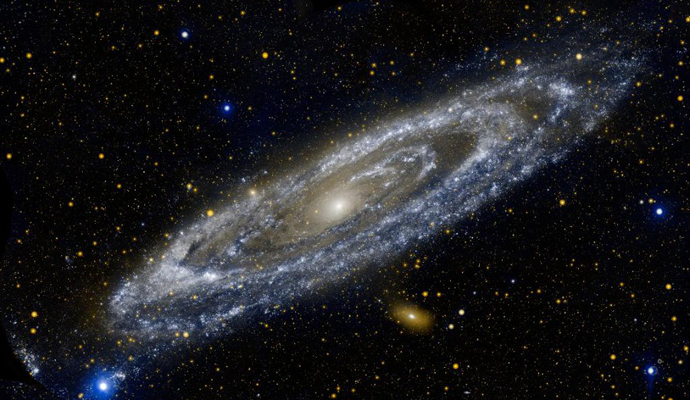8 stellar stories for your next stargazing trip
Yes, the constellation Globus Aerostaticus is named after a hot air balloon


The next time you're out stargazing, you might want to have some knowledge handy to sate the curiosity of your kids, impress a date, or just for your own edification. Here are eight stellar tidbits to keep in mind when you're not peering through a telescope or searching for meteors:
1) Where is the zodiac?
The zodiac is a band of 12 constellations lying along the ecliptic, which is the apparent path of the sun through the sky. To envision the ecliptic, think of a line running straight from the earth, through the sun and out into space. As Earth circles the sun, this imaginary line will rotate through space and point to different constellations. Traditionally, we've divided the zodiac into 12 constellations, with the sun passing through about one every month: Capricornus, the goat; Aquarius, the water-bearer; Pisces, the fish; Aries, the ram; Taurus, the bull; Gemini, the twins; Cancer, the crab; Leo, the lion; Virgo, the virgin; Libra, the scales; Scorpius, the scorpion; and Sagittarius, the centaur. The sun also seems to pass through a 13th constellation, Ophiuchus, the snake-bearer, which is sometimes included amongst the signs of the zodiac.
The Week
Escape your echo chamber. Get the facts behind the news, plus analysis from multiple perspectives.

Sign up for The Week's Free Newsletters
From our morning news briefing to a weekly Good News Newsletter, get the best of The Week delivered directly to your inbox.
From our morning news briefing to a weekly Good News Newsletter, get the best of The Week delivered directly to your inbox.
The dates given for the signs of the zodiac on astrology charts actually no longer correspond to when the sun is actually "moving" through that constellation, thanks to the phenomenon known as 'precession,' which is the Earth's slight wobble on its axis. Over the 2,500 years since the zodiac was first formulated, the signs have slipped to the west of their original positions because the north pole doesn't quite point in the same direction. So, if your birthday is in early August, an astrology chart will say your sign is Leo, but it's actually Cancer, one sign "earlier."
How to find the zodiac constellations: You can't actually see the constellation that the sun is currently "passing" through, because it's basically behind the sun, and thus obscured by it. But you can see the zodiac constellations nearby.
2) How do you get a constellation named after you?
Earning a place among the stars is sometimes referred to by the archaic term "catasterization." In Greek mythology, getting catasterized could either be a great honor or a form of punishment.
A free daily email with the biggest news stories of the day – and the best features from TheWeek.com
There are several different versions of just how the northern African queen Cassiopeia earned her place in the heavens. In one common telling of it, Cassiopeia boasts that both she and her daughter Andromeda were more beautiful than the Nereids, the sea nymphs. The sea nymphs, peeved, complained to Poseidon, and the god of the sea decided to stir up the ocean and send a great sea monster to threaten Cassiopeia's kingdom. Acting on the advice of an oracle, Cassiopeia and her husband chained Andromeda to a rock as a sacrifice to the monster. The hero Perseus managed to save Andromeda and kill the monster, but Poseidon decided to give the queen a punishment that stuck: he placed her up in the heavens, tied to a starry throne that acts as a torture device, as she's held upside down half the time as she circles around the pole star.
But not all catasterizations were punishments. There are multiple origin stories for the constellation Auriga, the charioteer, but one of the most common tellings is that the goddess Athena raised up Erichthonius, an early Athenian king, to honor him for inventing the four-horse chariot. Likewise, the god Apollo honored a dolphin who saved the poet and musician Arion from drowning by placing it in the sky as the constellation Delphinus.
How to find Cassiopeia: Find the Big Dipper and follow a line from the two stars on the far side of the cup, opposite the handle, through the North Star. Continue following the line until you see a W-shaped arrangement of stars, and that's Cassiopeia.
How to find Auriga: Again, the Big Dipper is helpful here. Follow a line between the two stars on the top of the "cup," in the direction away from the handle, about a quarter of the way around the horizon, where you'll come to a very bright star called Capella, one of the stars in the roughly pentagonal pattern that forms Auriga.
How to find Delphinus: This constellation is shaped like a diamond with a little tail, and is located just west of Pegasus, which itself can be found by drawing a line from the North star through Caph, a star at the tip of Cassiopeia.
3) What's the farthest star I can see?

Even if you need glasses to drive, your eyes can still see around 15 quintillion miles away. Under the right conditions, the most distant objects visible with the typical naked human eye are the Andromeda Galaxy, our nearest galactic neighbor and a mere 2.5 million light years away from Earth.
The farthest bright star that can be seen under most stargazing conditions is Deneb, located in the tail of the swan constellation Cygnus, around 1,500 light-years from Earth (nearly nine quadrillion miles away).
How to find Andromeda: Locate Cassiopeia and Pegasus. The constellation Andromeda lies between them, and the sharper of Cassiopeia's two angles will point roughly at the Andromeda Galaxy that also lies there. With the naked eye, you may not be able to distinguish the galaxy from an ordinary star; with binoculars or a telescope, the more ovoid shape of the galaxy should appear.
How to find Deneb: If you draw a line between the two stars forming the side of the "cup" of the Big Dipper, closest to the handle, traveling in the direction of the North Star, you will run straight into Deneb.
4) How long is Orion's belt?
1,200 light years across… or maybe just 69 light years across. Depends on how you measure it.
Orion's belt is formed by three stars: Alnitak (actually a triple-star system), Alnilam (a blue supergiant), and Mintaka (another multiple star system).
But though the three stars appear to be lined up, remember that that's only from our vantage point. In reality, they're arranged in a very skinny triangle. Alnitak and the middle star, Alnilam, are 563 light-years (3.3 quadrillion miles) apart; Alnilam and Mintaka are 621 light years (3.7 quadrillion miles) apart. But the Alnitak and Mintaka, the two stars on the extreme ends of the belt, are just 69 light-years (405.6 trillion miles) apart.
How to find Orion's belt: Look for three bright stars close together.
Additional note: If you want to know the distance between two stars, Wolfram Alpha is an easy-to-use tool: just plug in "distance between [first star name] (star) and [second star name] (star) and you're good to go!
5) Setting your calendar by the stars
The Pleiades — a cluster of stars in the constellation Taurus, also known as the Seven Sisters — were extremely important to the Aztecs, who named them Tianquiztli. When the Pleiades slipped beneath the horizon, disappearing from the night sky, that corresponded to when the sun would be at its highest point in the sky, and heralded the coming of the rainy season. The return of the Pleiades would mark the sun's lowest point, and the arrival of the dry season.
How to find the Pleiades: Draw a line across Orion's belt from left to right, and follow this until you see a bright smear of light.
6) What made the Milky Way?

One of the most important features of the night sky is the streak of stars that marks the Milky Way, our vantage point into the thickest part of the Milky Way Galaxy. Because the Milky Way is so distinctive, it's no surprise that almost every human culture has produced myths about it.
In some Eastern Asian cultures, the Milky Way is a river separating two lovers in the sky, who can meet only once a year when birds form a bridge over the divide. Ancient Egyptians thought the Milky Way was a pool of milk from a divine cow; the ancient populations of Estonia, Finland, Latvia, and Lithuania called it the "birds' road." Greco-Roman mythology also associated the Milky Way with milk: the god Zeus let his demigod son Herakles nurse on the goddess Hera while she was sleeping; when she woke up, she wrenched her breast out of the baby's mouth and spurted milk across the heavens.
How to find the Milky Way: You're in it! Just about every star you see is part of the Milky Way Galaxy. But in order to see the classic smudge-like streak of the Milky Way, you'll get best results in summertime near midnight. But you'll need to be far away from city lights, and you'll have to be patient; your eyes will take some time to adjust to the dark. In the Northern Hemisphere, the Milky Way arches across the eastern sky.
7) Who decides what is a constellation?
You've probably heard of constellations like Orion the hunter and Draco the dragon… but what about Noctua, the Owl? Or Globus Aerostaticus the hot air balloon? Or Ramus Pomifer, the apple branch held by Hercules? All of those unfamiliar names are obsolete constellations — starry pictures mapped out by scholars centuries ago, but which didn't make the cut of 88 official modern constellations adopted by the International Astronomical Union in 1922.
There's also systems of constellations originating from other cultures besides the Greco-Roman tradition. In China, where scholars were laboring to map the skies long before the Greeks, astronomers compiled a list of around 255 major constellations, organized in 28 groups called "mansions," themselves divided into four quarters associated with a specific compass direction, season, and mythical creature (for instance, the eastern quadrant of the sky is associated with spring, and represented by a blue dragon).
8) How can I find my favorite planet or constellation?
Want more help finding Saturn or Draco? If you have a smartphone, your best bet is Google Sky Map, which uses your mobile device's internal compass, GPS and clock to create an overlay outlining the stars, space objects, and constellations around you.
More from World Science Festival...


